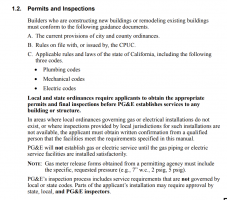jar546
Forum Coordinator
2014 NEC applies, here is the scenario.
Inspection for a temp service for a commercial construction site.
Temp Service with #6 copper THWN to panel with a 60A breaker (used as main) along with a 30A and two 20A breakers supplying 4 GFCI receptacles. The wire to the temp mast was THHN black, red and another black with white tape to signify neutral (strike one), there was just one ground rod installed (strike 2), upon further inspection there was heavy oxidation on all connection and when I gave a slight tug on the service conductors from the mast to the 60A breaker, they just pulled right out they were so loose (strike 3). Some other wires on the neutral bar also pulled right off from being so loose (see strike 3). No electrician on site, just the GC who gave the news to. His first response was: "I never heard of 2 ground rods, is that new?" He then proceeded to call the electrician to tell him he failed the inspection. When he broke the news and told him he was standing here with the inspector, the electrician's lound response was "That's fu^&'n bulls&^$t!" at which point I stated that I am not here to argue and to please call for a reinspection when you are ready.
So the NEC violations were:
250.53(A)(2)
110.14
200.6
Would anyone have added anything else or done something different?
I forgot to check for 408.36(D) when I was there so I hope that is not an issue on reinspection.
Inspection for a temp service for a commercial construction site.
Temp Service with #6 copper THWN to panel with a 60A breaker (used as main) along with a 30A and two 20A breakers supplying 4 GFCI receptacles. The wire to the temp mast was THHN black, red and another black with white tape to signify neutral (strike one), there was just one ground rod installed (strike 2), upon further inspection there was heavy oxidation on all connection and when I gave a slight tug on the service conductors from the mast to the 60A breaker, they just pulled right out they were so loose (strike 3). Some other wires on the neutral bar also pulled right off from being so loose (see strike 3). No electrician on site, just the GC who gave the news to. His first response was: "I never heard of 2 ground rods, is that new?" He then proceeded to call the electrician to tell him he failed the inspection. When he broke the news and told him he was standing here with the inspector, the electrician's lound response was "That's fu^&'n bulls&^$t!" at which point I stated that I am not here to argue and to please call for a reinspection when you are ready.
So the NEC violations were:
250.53(A)(2)
110.14
200.6
Would anyone have added anything else or done something different?
I forgot to check for 408.36(D) when I was there so I hope that is not an issue on reinspection.

